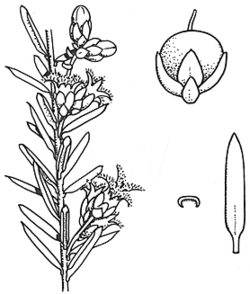Acrothamnus hookeri (Sond.) Quinn APNI* Synonyms: Leucopogon hookeri Sond. APNI*

Description: Erect often bushy shrub, usually c. 50 cm high; branchlets minutely scabrous.
Leaves oblong, 4.0–9.2 mm long, 1.1–2.5 mm wide; margins entire and finely toothed towards apex; lamina glabrous, discolorous, upper surface flat to convex, lower surface often glaucous and with 3 central ± parallel veins; petiole 0.5–1.2 mm long.
Flowers erect, unisexual or rarely bisexual, 1–8 together in spikes up to 9 mm long, white; bracteoles 1.2–1.7 mm long. Sepals 1.75–2.6 mm long. Corolla tube pubescent near throat; in male flowers tube 2.2–2.5 mm long, lobes 2–2.1 mm long; in female flowers tube 1.8–1.9 mm long, lobes c. 1.5 mm long.
Fruit obovoid or depressed-globose, 2.2–2.6 mm long, glabrous.
Flowering: October–January
Distribution and occurrence: Grows in subalpine woodland and shrubland and alpine heath on damp rocky soils; chiefly in New England and Barrington Tops in the north, the Brindabella Ra. and Kosciusko areas in the south.
NSW subdivisions: NT, ST, CWS
Other Australian states: Vic.
Text by J. M. Powell, except for groups with contributors listed
Taxon concept: Flora of NSW 3 (1992) as Leucopogon hookeri
APNI* Provides a link to the Australian Plant Name Index (hosted by the Australian National Botanic Gardens) for comprehensive bibliographic data
***The AVH map option provides a detailed interactive Australia wide distribution map drawn from collections held by all major Australian herbaria participating in the Australian Virtual Herbarium project.
|


